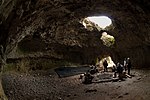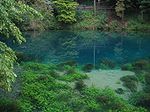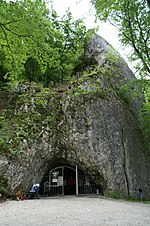Geissenklösterle
Art of the Upper PaleolithicCaves of GermanyGeography of Baden-WürttembergLandforms of Baden-WürttembergPrehistoric sites in Germany ... and 1 more
World Heritage Sites in Germany

Geissenklösterle (Geißenklösterle) is an archaeological site of significance for the central European Upper Paleolithic, located near the town of Blaubeuren in the Swabian Jura in Baden-Württemberg, southern Germany. First explored in 1963, the cave contains traces of early prehistoric art from between 43,000 and 30,000 years ago, including some of the oldest-known musical instruments and several animal figurines. Because of the historical and cultural importance of these findings, in 2017 the site became part of the UNESCO World Heritage Site Caves and Ice Age Art in the Swabian Jura.
Excerpt from the Wikipedia article Geissenklösterle (License: CC BY-SA 3.0, Authors, Images).Geissenklösterle
Bruckfelsstraße, Gemeindeverwaltungsverband Blaubeuren
Geographical coordinates (GPS) Address Website External links Nearby Places Show on map
Geographical coordinates (GPS)
| Latitude | Longitude |
|---|---|
| N 48.398333333333 ° | E 9.7722222222222 ° |
Address
Geißenklösterle
Bruckfelsstraße
89143 Gemeindeverwaltungsverband Blaubeuren
Baden-Württemberg, Germany
Open on Google Maps










